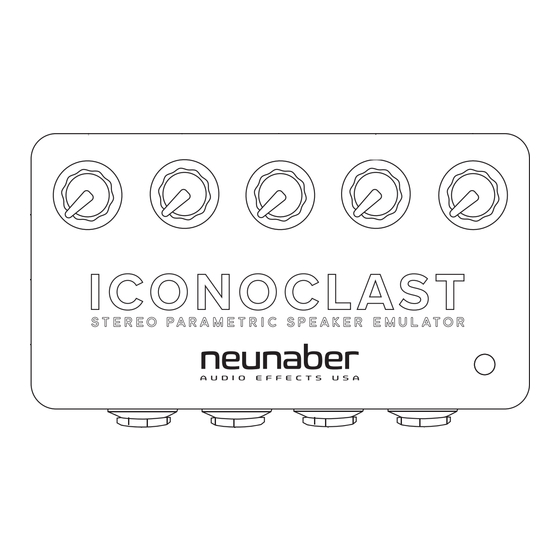
Table of Contents
Advertisement
Quick Links
Advertisement
Table of Contents

Summary of Contents for Neunaber ICONOCLAST
- Page 1 ICONOCLAST...
- Page 2 Thank you for purchasing our product. We really mean it. We hope to earn your trust by delivering a quality product that inspires you to make great music. Neunaber products are designed and manufactured in Orange, California USA. Please visit www.neunaber.net for more information and support.
- Page 3 PEDAL MAP high headphone noise gate level threshold jack 9V DC on / headphone gate closed / jack clip indicator left right left right/mono balanced or unbalanced unbalanced outputs inputs...
- Page 4 INTRODUCTION Loudspeakers used for guitar amplification do more than simply make the signal louder. They dramatically shape the signal—significantly attenuating very low and very high frequencies, while less dramatically affecting other frequencies. Furthermore, the loudspeaker can interact with the amplifier that drives it, resulting in a dynamic response.
- Page 5 IRs. Placed after your pedals and/ or preamp, Iconoclast completes your signal chain and provides a direct output to headphones, a recording interface, mixer or powered speakers.
-
Page 6: Headphone Output
CONNECTIONS Iconoclast should be placed at the end of your signal chain, after your pedals and/ or preamp. Iconoclast is not a load box and must not be connected to the speaker output of an amplifier. POWER Connect a standard 9V DC or 12V DC, 100 mA or greater, center-negative pedal power supply (not included) to the power input. -
Page 7: Led Indicator
LED INDICATOR The color of the LED indicates the current status: • White indicates normal operation. • Blue indicates the noise gate is closed. • Red indicates input clipping, in which case the input level should be reduced by reducing the output level of the preamp or drive pedal. -
Page 8: Mono In / Mono Out
MONO IN / MONO OUT OUTPUT INPUT The outputs are dual mono: either may be used and The input is a TS cable in the R input only, from may be a TS (unbalanced) or TRS balanced cable. If either an instrument, pedal output, or preamp a TRS balanced cable is used, the other end may be output. - Page 9 MONO IN / STEREO OUT OUTPUT INPUT The outputs may be TS (unbalanced) or TRS The input is a TS cable in the R input only, from balanced cables. If TRS balanced cables are used, either an instrument, pedal output, or preamp the other end of the cables may be either 1/4”...
- Page 10 STEREO IN / STEREO OUT OUTPUT INPUT The outputs may be TS (unbalanced) or TRS The inputs are TS cables from a pedal or balanced cables. If TRS balanced cables are preamp outputs. used, the other end of the cables may be either 1/4”...
- Page 11 TRS STEREO IN / STEREO OUT OUTPUT INPUT The outputs may be TS (unbalanced) or TRS The input is a TRS stereo cable into the L input only. balanced cables. If TRS balanced cables are used, The R input must be disconnected. the other end of the cables may be either 1/4”...
- Page 12 AMPLIFIER DIRECT INTERFACE OUTPUT INPUT Use TRS balanced cable. A ground lift is only The input may be mono or stereo from required if ground loop hum is present. your amplifier. Do not connect to the amplifier’s return. The outputs can be run to a mixer or recording interface.
- Page 13 AMPLIFIER DIRECT INTERFACE WITH EFFECTS OUTPUT INPUT Use TRS balanced cable. A ground lift is only Use a “Y” or splitter cable to create a required if ground loop hum is present. bypass connection to your amplifier’s return. The outputs can be run to a mixer or recording interface.
-
Page 14: Headphone Level
CONTROLS HEADPHONE LEVEL The Headphone Level knob controls the level of the Headphone Output. It does not affect the level of the L/R outputs. To protect your hearing, start with this knob turned down and adjust upward only if needed. Turn this knob down when connecting/disconnecting cables or power to the device. -
Page 15: Noise Gate
However, many guitar speakers retain a small amount of signal “fizz” beyond their cutoff frequency. Iconoclast reproduces both the sharp drop off and fizz of a guitar speaker and does so using adjustable filters. The drop off frequency is directly adjustable with the High knob. -
Page 16: Feature Overview
• Viewing of third-party IR response for comparison Please see the Software User Guide at neunaber.net/iconoclast-software-user-guide. To use Iconoclast Software: • Download Iconoclast Software at neunaber.net/iconoclast-software • Connect your Iconoclast hardware to a USB port via a micro-B cable (included). • Install and launch Iconoclast Software... - Page 17 SPECIFICATIONS Inputs Unbalanced: mono (R only), stereo (L/R), stereo TRS (L only) Nominal Input Level -10 dBV, instrument/consumer line level Absolute Max Input Level 6 dBV Input Impedance 1 MΩ (mono), 2 MΩ (stereo) Outputs Impedance-balanced: mono (L or R), stereo (L/R) Output Impedance 100 Ω...
-
Page 18: Specifications
SPECIFICATIONS Power Power Input 9-12 V DC Current w/o Phones 60 mA typical Current w/ 32 Ω Phones 100 mA @ max phones level Current w/ 16 Ω Phones 120 mA @ max phones level Connector center-negative, 5.5 mm OD x 2.1 mm ID Recommended Adapter 9 V DC, 100 mA or greater, (Boss-compatible) pedal power supply... - Page 19 While we believe our products are not harmful when used as designed, we provide this warning to comply with Proposition 65. © 2016 Neunaber Technology LLC. All rights reserved. Neunaber logo, and Iconoclast™ are trademarks of Neunaber Technology, LLC.
- Page 20 net...




Need help?
Do you have a question about the ICONOCLAST and is the answer not in the manual?
Questions and answers